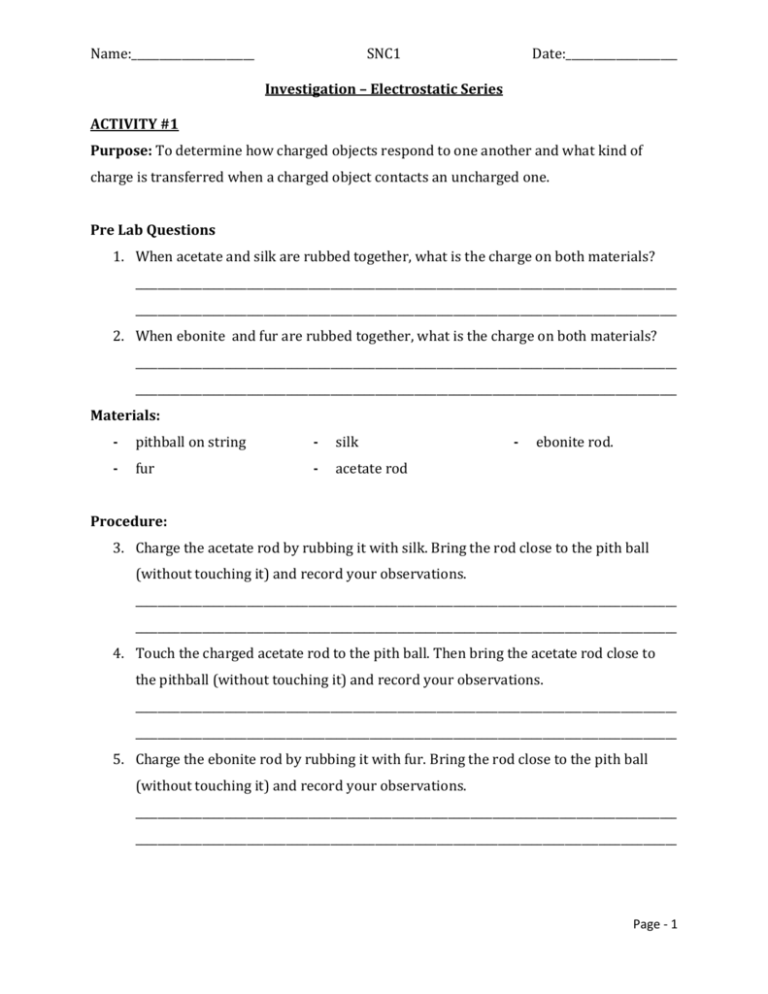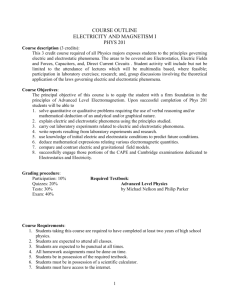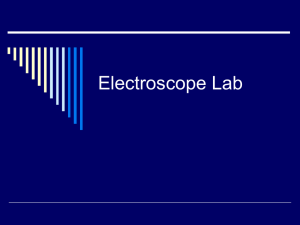Investigation – Electrostatic Series ACTIVITY #1 Purpose: To determ
advertisement

Name:______________________ SNC1 Date:____________________ Investigation – Electrostatic Series ACTIVITY #1 Purpose: To determine how charged objects respond to one another and what kind of charge is transferred when a charged object contacts an uncharged one. Pre Lab Questions 1. When acetate and silk are rubbed together, what is the charge on both materials? _________________________________________________________________________________________________ _________________________________________________________________________________________________ 2. When ebonite and fur are rubbed together, what is the charge on both materials? _________________________________________________________________________________________________ _________________________________________________________________________________________________ Materials: - pithball on string - silk - fur - acetate rod - ebonite rod. Procedure: 3. Charge the acetate rod by rubbing it with silk. Bring the rod close to the pith ball (without touching it) and record your observations. _________________________________________________________________________________________________ _________________________________________________________________________________________________ 4. Touch the charged acetate rod to the pith ball. Then bring the acetate rod close to the pithball (without touching it) and record your observations. _________________________________________________________________________________________________ _________________________________________________________________________________________________ 5. Charge the ebonite rod by rubbing it with fur. Bring the rod close to the pith ball (without touching it) and record your observations. _________________________________________________________________________________________________ _________________________________________________________________________________________________ Page - 1 Name:______________________ SNC1 Date:____________________ Investigation – Electrostatic Series 6. Touch the charged ebonite rod to the pith ball. Then bring the ebonite rod close to the pithball (without touching it) and record your observations. _________________________________________________________________________________________________ _________________________________________________________________________________________________ 7. Charge the pithball by touching it with the charged ebonite rod. Bring the charged acetate rod close to the pithball and record your observations. _________________________________________________________________________________________________ _________________________________________________________________________________________________ 8. Charge the pithball by touching it with the charged acetate rod. Bring the charged ebonite rod close to the pithball and record your observations. _________________________________________________________________________________________________ ________________________________________________________________________________________________ Illustrations Draw a diagram to represent the charges on each of the materials before and after each procedure step, based on your observations Step # Before After Page - 2 Name:______________________ SNC1 Date:____________________ Investigation – Electrostatic Series Discussion Questions 9. How do objects with the same charge respond to one another? _________________________________________________________________________________________________ ________________________________________________________________________________________________ 10. How do objects with the opposite charge respond to one another? _________________________________________________________________________________________________ ________________________________________________________________________________________________ Page - 3 Name:______________________ SNC1 Date:____________________ Investigation – Electrostatic Series ACTIVITY#2 Purpose: To understand electric static charge Pre Lab Questions 11. Where is acetate located on the electrostatic series? _____________________ 12. Where is vinyl located on the electrostatic series? _____________________ 13. Where is paper located on the electrostatic series? _____________________ Materials - clear strip (Acetate) - one paper towel - green strip (Vinyl) - watch glass Procedure 14. Place the watch glass round part facing down so that it can rotate freely 15. Charge the green strip with the paper towel by rubbing it vigorously on one side 16. Balance it on the watch glass. 17. Charge up the clear strip with the paper towel by rubbing it vigorously on one side 18. Put the clear strip NEAR the green strip (do NOT touch it). 19. Record your observations in the table below 20. Repeat the previous steps but switch the position of each material 21. Record your observations below 22. Repeat the previous steps but use the same materials (see observation tables) Observations Clear strip NEAR green strip on watch glass Green strip NEAR green strip on watch glass What happened? What happened? Why? Why? Page - 4 Name:______________________ SNC1 Date:____________________ Investigation – Electrostatic Series Clear strip NEAR clear strip on watch glass Green strip NEAR clear strip on watch glass What happened? What happened? Why? Why? Illustrations Draw a diagram to represent the charges on each of the materials before and after each procedure step, based on your observations Step # Before After Page - 5 Name:______________________ SNC1 Date:____________________ Investigation – Electrostatic Series Discussion Questions 23. If I put a negative charge near a negative charge, it __________________________ 24. If I put a positive charge near a negative charge, it __________________________ 25. If I put a positive charge near a positive charge, it ___________________________ Page - 6 Name:______________________ SNC1 Date:____________________ Investigation – Electrostatic Series ACTIVITY #3 Purpose: In this activity, you will make a light bulb glow without using electricity from a wall outlet or a battery. Pre-Lab Questions 26. Read over the procedure. What will the light bulb be used for? ________________________________________________________________________________________________ 27. Where is wool located on the electrostatic series? _____________________ 28. Where is vinyl located on the electrostatic series? _____________________ 29. Where is ebonite located on the electrostatic series? _____________________ Materials - Piece of wool - fluorescent light bulb (not an incandescent bulb) - green strip (Vinyl) - ebonite rod Safety: Handle the glass light bulb with care to avoid breakage. Procedure 30. Dim the overhead lights in the room. 31. Vigorously rub the plastic comb with a piece of wool or flannel. 32. Touch the part of the comb that was rubbed to the light bulb and observe/record carefully. _________________________________________________________________________________________________ ______________________________________________________________________________________________ 33. Repeat the above but using an ebonite rod. Observe/record carefully. _________________________________________________________________________________________________ ______________________________________________________________________________________________ Page - 7 Name:______________________ SNC1 Date:____________________ Investigation – Electrostatic Series Discussion Questions 34. Use an electrostatic series to determine the charge of the vinyl stick after it was rubbed with the piece of wool. _________________________________________________________________________________________________ ______________________________________________________________________________________________ 35. What did you observe when the rubbed vinyl was touched to the light bulb? Use static electricity to explain why this result occurred. _________________________________________________________________________________________________ ______________________________________________________________________________________________ 36. Was there a difference in your observations from when you used the vinyl and when you used the ebonite? Should there have been? Explain why _________________________________________________________________________________________________ _________________________________________________________________________________________________ _________________________________________________________________________________________________ ___________________________________________________________________________________________ Page - 8 Name:______________________ SNC1 Date:____________________ Investigation – Electrostatic Series ACTIVITY #4 Purpose: Use and understand how an electroscope works by both induction and conduction. Pre Lab 37. Read the Background Information below and describe in your own words what an electroscope is and how it is used. _________________________________________________________________________________________________ ______________________________________________________________________________________________ Materials - Piece of wool - ebonite rod - Glass rod - electroscope Background Information An electroscope is a device that is used to detect and identify a static charge. We will use the metal leaf electroscope, it has two strips of metal that bend easily and the leaves are attached to a central metal rod with a metal sphere at the top. Charges move freely within the metal (conductor). Electroscopes can be charged by contact, the object will end up with the same charges as the charging object. Discharging is when electrons are added or removed from a charged object to restore a neutral charge Charging something through induction is creating a charge on an object without actually contacting it. When you bring a charged object close to a neutral object, you create a separation in charges making one side of the object positively charged and the other side negatively charged. Page - 9 Name:______________________ SNC1 Date:____________________ Investigation – Electrostatic Series Electroscope A device for detecting the presence of electric charge Procedure 38. Charge the black rod first with the fur and go towards the scope either touching the scope directly or hovering above it. 39. Touching the scope is conduction and not touching the scope is induction. 40. Record your observations. Note what happens for conduction and induction. _________________________________________________________________________________________________ ______________________________________________________________________________________________ 41. Repeat the same thing for the glass rod. Note what happens for conduction and induction. _________________________________________________________________________________________________ ______________________________________________________________________________________________ Discussion Questions 42. What was the charge on the aluminum foil when the ebonite rod was used? _________________________________________________________________________________________________ ______________________________________________________________________________________________ 43. What was the charge on the aluminum foil when the glass rod was used? _________________________________________________________________________________________________ ______________________________________________________________________________________________ Page - 10 Name:______________________ SNC1 Date:____________________ Investigation – Electrostatic Series ACTIVITY #5 Purpose: To understand how a rubber balloon can become electrically charged. Pre-Lab Questions 44. Where is the rubber balloon located on the electrostatic series? ________________ 45. Where is human hair located on the electrostatic series? ________________ Materials - Paper strips - Styrofoam - paper clips - balloon Procedure 46. Inflate a balloon and tie a knot (if not already done so) 47. Rub the balloon on your shirt to create electric static 48. Move it towards the items listed on the chart below and record whether the balloon was attracted to the object, repelled the object, or no reaction occurred. Record your observations in the table below. 49. Include an illustration (including the charges for both materials) Observations Balloon with… Attract or repel Illustration Shirt or hair Paper clips Page - 11 Name:______________________ SNC1 Date:____________________ Investigation – Electrostatic Series Strips of paper A different balloon Styrofoam Drywall Page - 12







